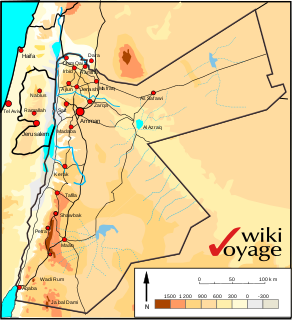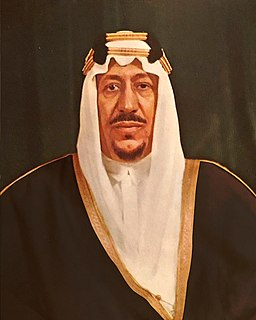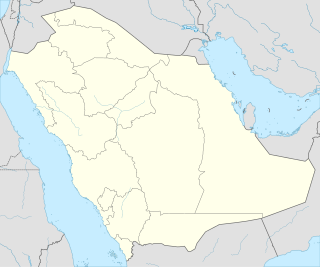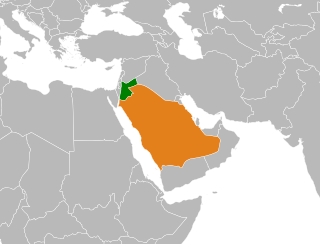| |||||
| Decades: | |||||
|---|---|---|---|---|---|
| See also: | |||||
| |||||
| Decades: | |||||
|---|---|---|---|---|---|
| See also: | |||||

Jordan is situated geographically in Southwest Asia, south of Syria, west of Iraq, northwest of Saudi Arabia and east of Palestine, and the West Bank; politically, the area has also been referred to in the West as the Middle or Near East. The territory of Jordan now covers about 91,880 square kilometres (35,480 sq mi).

The Kingdom of Saudi Arabia is a country situated in Southwest Asia, the largest country of Arabia, by the Arabian Peninsula, bordering the Persian Gulf and the Red Sea, north of Yemen. Its extensive coastlines on the Persian Gulf and Red Sea provide great leverage on shipping through the Persian Gulf and the Suez Canal. The kingdom occupies 80% of the Arabian Peninsula. Most of the country's boundaries with the United Arab Emirates (UAE), Oman, and the Republic of Yemen are undefined, so the exact size of the country remains unknown. The Saudi government estimate is at 2,217,949 square kilometres, while other reputable estimates vary between 2,149,690 and 2,240,000 sq. kilometres. Less than 7% of the total area is suitable for cultivation, and in the early 1960s, population distribution varied greatly among the towns of the eastern and western coastal areas, the densely populated interior oases, and the vast, almost empty deserts.

The Arabian Peninsula is a peninsula of Western Asia, situated northeast of Africa on the Arabian Plate. At 3,237,500 km2 (1,250,000 sq mi), the Arabian Peninsula is the largest peninsula in the world.

The Cooperation Council for the Arab States of the Gulf, originally known as the Gulf Cooperation Council, is a regional, intergovernmental political and economic union that consists of Bahrain, Kuwait, Oman, Qatar, Saudi Arabia, and the United Arab Emirates. The council's main headquarter is in the city of Riyadh in Saudi Arabia. The Charter of the GCC was signed on 25 May 1981, formally establishing the institution.

The Hejazrailway was a narrow-gauge railway that ran from Damascus to Medina, through the Hejaz region of modern day Saudi Arabia, with a branch line to Haifa on the Mediterranean Sea. It was a part of the Ottoman railway network and the original goal was to extend the line from the Haydarpaşa Terminal in Kadikoy beyond Damascus to the holy city of Mecca. However, construction was interrupted due to the outbreak of World War I, and it reached no further than Medina, 400 kilometres (250 mi) short of Mecca. The completed Damascus to Medina section was 1,300 kilometres (810 mi).

Saudi Arabia, officially the Kingdom of Saudi Arabia (KSA), is a country in Western Asia. It spans the vast majority of the Arabian Peninsula, with a land area of approximately 2,150,000 km2 (830,000 sq mi). Saudi Arabia is the fourth-largest country entirely in Asia, the largest in Western Asia, and the second-largest in the Arab world. It is bordered by the Red Sea to the west, Jordan, Iraq, and Kuwait to the north, the Persian Gulf, Qatar, and the United Arab Emirates to the east, Oman to the southeast, and Yemen to the south. Bahrain is an island country off the east coast. The Gulf of Aqaba in the northwest, whose maximum width is 24 km (15 mi), separates Saudi Arabia from Egypt. Saudi Arabia is the only country with a coastline along both the Red Sea and the Persian Gulf, and most of its terrain consists of arid desert, lowland, steppe, and mountains. Its capital and largest city is Riyadh. The country is home to Mecca and Medina, the two holiest cities in Islam.

Western Asia, West Asia, or Southwest Asia, is the westernmost subregion of the larger geographical region of Asia, as defined by some academics, UN bodies and other institutions. It is almost entirely a part of the Middle East, and includes Anatolia, the Arabian Peninsula, Iran, Mesopotamia, the Levant, the island of Cyprus, the Sinai Peninsula, and partly the Caucasus Region (Transcaucasia). The region is considered to be separated from Africa by the Isthmus of Suez in Egypt, and separated from Europe by the waterways of the Turkish Straits and the watershed of the Greater Caucasus. Central Asia lies to its northeast, while South Asia lies to its east. Eight seas surround the region (clockwise): the Aegean Sea, the Black Sea, the Caspian Sea, the Persian Gulf, the Arabian Sea, the Gulf of Aden, the Red Sea, and the Mediterranean Sea.

Saud bin Abdulaziz Al Saud was the King of Saudi Arabia from 9 November 1953 to 2 November 1964. Prior to his ascension, he served as the Crown Prince of Saudi Arabia from 11 May 1933 to 9 November 1953. He was the second son of King Abdulaziz, the founder of modern Saudi Arabia, and the first of Abdulaziz's six sons who were kings.

Salman bin Abdulaziz Al Saud is King of Saudi Arabia, reigning since 23 January 2015. Prior to his accession, he was Crown Prince of Saudi Arabia from 16 June 2012 to 23 January 2015. He is the 25th son of King Abdulaziz and the sixth of his sons who have reigned as kings.

Duba is a small city on the northern Red Sea coast, of Saudi Arabia. It is in Tabuk Province. Local citizens describe it as The Pearl of the Red Sea. The population of Duba is about 22,000.

Ḥaql or Ḥaqal is a city in the northwest of Saudi Arabia near the head of the Gulf of Aqaba, adjacent to Aqaba across the Jordanian border. The coasts of Egypt, Israel and Jordan can be seen from Haql.
The 1990 AFC U-16 Championship, was the fourth iteration of the AFC U-16 Championship, a tournament organised by the Asian Football Confederation (AFC) and held every two years for Asian under-16 teams.

This is a list of the competitive matches played by the Syrian football team since its inception.

Arar is the capital of Northern Borders Province in Saudi Arabia. It has a population of 145,237.

Jordan–Saudi Arabia relations are the relations between the Hashemite Kingdom of Jordan and the Kingdom of Saudi Arabia.
Pakistan Armed Forces deployments include all Pakistani military deployments that are stationed outside Pakistan and serving in other countries. The sixth largest military power in terms of active troops, Pakistan has an extensive history of overseas military presence, especially in the Middle East, where it has maintained military contingents, missions and battalions in several states. As part of its foreign policy efforts to expand its military relations and influence in the region, Pakistan signed defence protocols during the 1970s with several Arab countries including Saudi Arabia, Libya, Jordan, Iraq, Oman, the United Arab Emirates and Kuwait, under which members of the armed forces of these countries were imparted professional training by Pakistani advisers and military trainers. Saudi Arabia signed a bilateral agreement with Pakistan on defense cooperation; during that time, there were 50,000 to 60,000 Pakistani military personnel serving abroad with the largest number of these, about 20,000, deployed in Saudi Arabia.
Events from the year 1951 in Jordan.
Events from the year 1991 in Jordan.

The Qatar–Saudi Arabia diplomatic conflict refers to the ongoing struggle for regional influence between Qatar and Saudi Arabia (KSA), both of which are members of the Gulf Cooperation Council (GCC). Qatar–Saudi Arabia relations have been especially strained since the beginning of the Arab Spring, that left a power vacuum both states sought to fill, with Qatar being supportive of the revolutionary wave and Saudi Arabia opposing it. Both states are allies of the United States, and have avoided direct conflict with one another.

This is a list of the Saudi Arabia national football team results from 1957 to 1979.